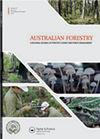Towards an integrative perspective on commercialised wild-gathered bamboo use: insights into the extraction of lung bamboo in the Vietnamese uplands
IF 0.9
4区 农林科学
Q3 FORESTRY
引用次数: 1
Abstract
ABSTRACT Bamboo is a vital non-timber forest product (NTFP) and income source for rural communities in the Global South, including in Latin America, Asia, Africa and Oceania. Due to the manifold goods and services it provides to society, bamboo has recently drawn considerable attention in the forest-development discourse. The potential that bamboo offers as a substitute for timber in the industrialised production of pulp, paper, charcoal and flooring is spurring bamboo commercialisation in light of nascent bamboo-processing industries. This is most apparent in Asia, where Viet Nam has some of the largest forest bamboo resources and ambitious government plans aim to boost sector development in the future. As is observable worldwide, the bulk of bamboo in Viet Nam grows naturally, often as a weakly regulated common-pool resource. Hence, as for many other wild-gathered NTFPs, the commercialisation of the harvesting, trading and processing of forest bamboo raises questions about balancing use and conservation to achieve long-term sustainability. Empirical studies that provide an integrative perspective on wild-gathered bamboo commercialisation are rare. To close the knowledge gap, this exploratory study investigates the social, economic and ecological dimensions of the commercialisation of lung bamboo (Bambusa longissima sp. nov.), a native bamboo species endemic to north-central Viet Nam. We combined quantitative and qualitative social science research methods with a forest inventory of selected lung bamboo exploitation sites in the Que Phong district (a mountainous region of Nghe An province), where lung bamboo use constitutes a vital element of local livelihoods. Our results highlight the need to consider the complex interplay of local livelihoods, harvesting regimes, institutional arrangements and value-chain configurations to understand the ecological outcomes of wild-gathered bamboo commercialisation. We call for the adoption of an integrative perspective when designing practical project interventions, sector plans and policies for forest bamboo commercialisation. Promoting alternative livelihood options, robust and clear institutional arrangements to regulate access and tenure, capacity building in management and harvesting and, not least, supportive commodity-chain governance are critical elements on the pathway to greater sustainability in wild-gathered bamboo commercialisation.走向商业化野生采集竹使用的综合视角:对越南高地肺竹提取的见解
摘要竹子是全球南部(包括拉丁美洲、亚洲、非洲和大洋洲)农村社区的重要非木材林产品和收入来源。由于竹子为社会提供了多种商品和服务,竹子最近在森林发展的讨论中引起了相当大的关注。在纸浆、纸张、木炭和地板的工业化生产中,竹子作为木材替代品的潜力正在刺激竹子的商业化,因为竹子加工业刚刚起步。这在亚洲最为明显,越南拥有一些最大的森林竹资源,政府雄心勃勃的计划旨在促进未来的部门发展。正如在世界范围内可以观察到的那样,越南的大部分竹子都是自然生长的,通常是一种监管不力的共同资源。因此,与许多其他野生采集的NTFP一样,森林竹子的收割、交易和加工的商业化提出了平衡使用和保护以实现长期可持续性的问题。为野生竹的商业化提供综合视角的实证研究很少。为了缩小知识差距,本探索性研究调查了越南中北部特有的本地竹种龙竹(Bambusa longissima sp.nov.)商业化的社会、经济和生态层面。我们将定量和定性的社会科学研究方法与确峰区(义安省的一个山区)选定的肺竹开采点的森林调查相结合,在那里,肺竹的使用是当地生计的重要组成部分。我们的研究结果强调,需要考虑当地生计、采伐制度、制度安排和价值链配置的复杂相互作用,以了解野生采集竹子商业化的生态结果。我们呼吁在设计切实可行的项目干预措施、部门计划和森竹商业化政策时采用综合视角。促进替代生计选择、监管获取和保有权的强有力和明确的制度安排、管理和收获方面的能力建设,以及支持性的商品链治理,是野生竹商业化实现更大可持续性的关键因素。
本文章由计算机程序翻译,如有差异,请以英文原文为准。
求助全文
约1分钟内获得全文
求助全文
来源期刊

Australian Forestry
FORESTRY-
CiteScore
3.70
自引率
4.80%
发文量
15
审稿时长
>12 weeks
期刊介绍:
Australian Forestry is published by Taylor & Francis for the Institute of Foresters of Australia (IFA) for scientific, technical, and professional communication relating to forestry in the Asia Pacific.
 求助内容:
求助内容: 应助结果提醒方式:
应助结果提醒方式:


